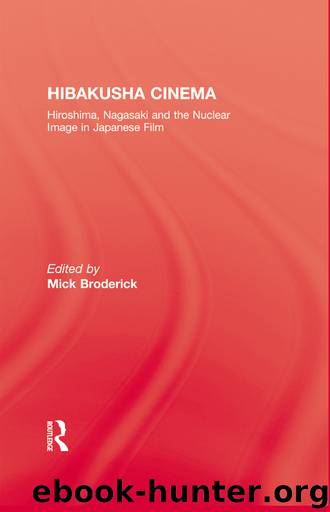Hibakusha Cinema by Broderick ;

Author:Broderick,; [Mick Broderick]
Language: eng
Format: epub
Publisher: Taylor and Francis
7.5 Daniel McGovern in Nagasaki, with Urakami Cathedral in the background. (McGovern Collection.)
On January 2, 1946, representatives from NAVTECHJAP, G-2, USSBS, and the Surgeon General’s Office met and decided that NAVTECHJAP would help Nichiei complete location photography, while the Strategic Bombing Survey would supervise Nichiei’s postproduction. The Surgeon General would receive a new work print of the 8,000 feet of medical film they already possessed. This meeting was actually the most crucial juncture in the history of The Effects of the Atomic Bomb on Hiroshima and Nagasaki. The decision to allow Nichiei to finish their film for the USSBS meant the Surgeon General’s Office would lose its claim and receive only unedited rushes. This footage is now maboroshi; had the decision weighed in the favor of the American doctors, it is likely Nichiei’s moving images of the atomic bombings would have been lost forever.
After this narrow miss, GHQ officially directed the USSBS to manage and fund Nichiei’s postproduction under the supervision of McGovern and Dan Dyer. Ironically, Dyer had been Chief Target Analyst for Major General LeMay’s superfortress squadrons, and had been in charge of target selection at the end of the war. Presumably this included Hiroshima and Nagasaki. GHQ also ordered the ‘confiscation’ and shipping of all materials to the Pentagon.20 On January 11, a memo to Iwasaki officially directed Nichiei to finish their film, asking for a complete budget for ‘services rendered,’ including all materials, expenses, labor and still photography. The memo also contained the following provision: ‘All caption material and research matter will be included and also all short ends and excess negative will be put in containers and marked with a number. . . All phases of the picture, Hiroshima, Nagasaki and the medical section will be completed and ready for turning over to the USSBS Motion Picture Project on or before 1 March 1946. . . . No other organization will be permitted to confiscate or remove the material from the Nippon Newsreel Company.’21
This memo came as quite a shock to the Japanese filmmakers, and has achieved considerable notoriety in the history of Japanese cinema.22 In fact, multiple versions of the incident have circulated over the past 50 years. Many writers, Nichiei filmmakers and historians alike, describe a scenario months later near the end of postproduction, in which Nichiei is suddenly informed that every scrap of evidence of the film is to be turned over. Some histories describe the signing of an oath of silence. Nearly all of them suggest an atmosphere of oppression. This memo to Iwasaki at the beginning of postproduction suggests these stories are somewhat inflated.23
Be that as it may, the word ‘confiscation’/’ftastf/iw’ meant something quite different to each side. In the world of the American military men, it was hardly unusual vocabulary; it meant picking up services rendered from Nichiei.24 From the perspective of the Japanese filmmakers, this ‘bosshu’ was akin to theft. After all, the bulk of the film had been shot and developed with Japanese money before the Americans arrived on the scene.
Download
This site does not store any files on its server. We only index and link to content provided by other sites. Please contact the content providers to delete copyright contents if any and email us, we'll remove relevant links or contents immediately.
Call Me by Your Name by André Aciman(19897)
Ready Player One by Cline Ernest(13978)
How to Be a Bawse: A Guide to Conquering Life by Lilly Singh(7154)
Wiseguy by Nicholas Pileggi(5315)
The Kite Runner by Khaled Hosseini(4950)
On Writing A Memoir of the Craft by Stephen King(4661)
Audition by Ryu Murakami(4612)
The Crown by Robert Lacey(4570)
Call me by your name by Andre Aciman(4463)
Gerald's Game by Stephen King(4373)
Harry Potter and the Cursed Child: The Journey by Harry Potter Theatrical Productions(4314)
Dialogue by Robert McKee(4160)
The Perils of Being Moderately Famous by Soha Ali Khan(4064)
Dynamic Alignment Through Imagery by Eric Franklin(3919)
Apollo 8 by Jeffrey Kluger(3512)
How to be Champion: My Autobiography by Sarah Millican(3493)
The Inner Game of Tennis by W. Timothy Gallwey(3472)
Seriously... I'm Kidding by Ellen DeGeneres(3412)
Darker by E L James(3405)
